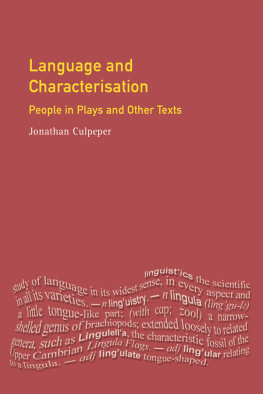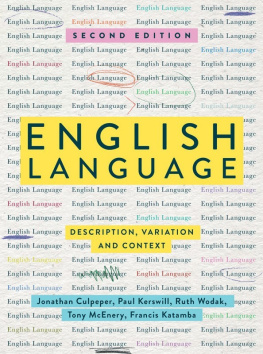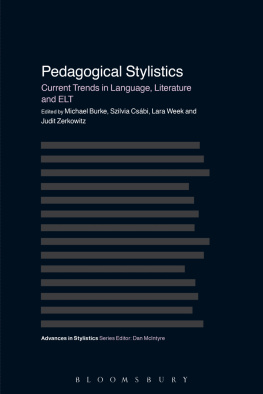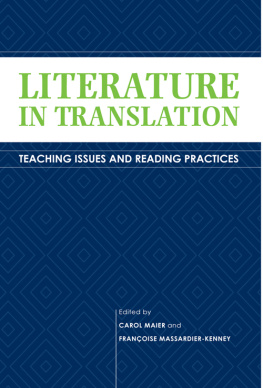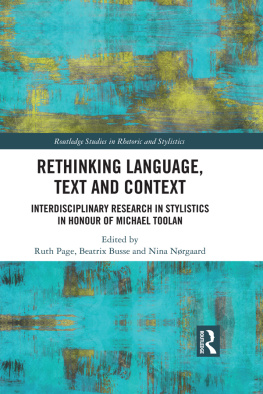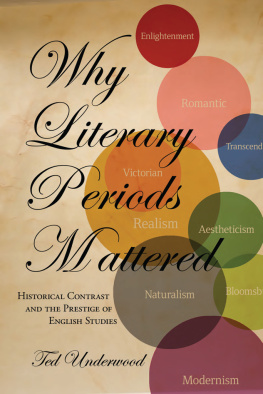In this book, I explore how the words of a text create a particular impression of a character in the readers head. I focus on three interrelated questions:
- 1) How does the readers prior knowledge contribute to characterisation?
- 2) How does the reader infer characteristics from the text?
- 3) What are the textual cues in characterisation?
From these questions, it will immediately be apparent that my concern is mainly with the process of characterisation, rather than with character the output of that process. The approach I take is multi-disciplinary: the book draws together theories from linguistics (particularly from pragmatics), cognitive psychology (such as schema theory), social psychology (for example attribution theory), and stylistics (for example foregrounding theory). I will show through the analysis of textual examples how these theories interrelate and how they can explicate the mechanisms of characterisation. It may help readers to know that I consider this book to be part of the emerging field of cognitive stylistics (see for instance Freeman 1995; Emmott 1997; Semino 1997). Like the works just cited, the general approach of this book will be to hypothesise about comprehension through an examination of the text, although I will also report some limited empirical work (see Emmott 1997: 9498 for a description of this approach).
The dialogue of plays is the primary focus of this book. Most recent research on characterisation has dwelt on prose fiction. In two fairly recent special journal issues on literary character, Poetics Today (1986) and Style (1990), only one article addressed the issue of character in drama. A number of books have theorised about character in the novel, This is surprising, since it is in drama that characters are particularly salient. Unlike typical prose fiction, in drama there is usually no narrator who intervenes and guides our perception of a character: we are exposed in a direct way to their words and actions, and, of course, on stage we are exposed to their very physical presence.
Although I will discuss the characterisation of a wide variety of characters (ranging from the characters of the childrens television series Teletubbies through to the characters of medieval Morality plays), I will draw the majority of my examples from Shakespeares plays. This is for three reasons: (1) Shakespeares plays offer a rich collection of characters; (2) since Shakespeare is a playwright who uses few stage directions, we rely almost exclusively on dialogue for characterisation; and (3) Shakespeares characters are well known and frequently the subject of discussion. However, relying solely on examples from Shakespeare would be problematic. Firstly, the audience of 400 years ago will have had rather different background knowledge from that of the present day, and, secondly, Shakespeare does not exploit the full textual range of characterisation (for example, spelling, lexis and grammar are little used in the creation of a particular social dialect). Thus, I also discuss examples from other more recent plays. In addition, I analyse examples from other text-types, both literary (such as prose fiction) and non-literary (such as advertisements). The involvement of a wide range of text-types is important as a way of demonstrating that what I propose constitutes a general theory of characterisation.
At this early point, I need to address some tricky terminological issues. The problem with the word character is that it is ambiguous. Amongst the various usages, it can be used to refer to the qualities the characteristics that combine to form a persons personality, or the people that inhabit the fictional worlds of books, plays, films, and so on. In this book, I will use characteristics for the former sense, and character for the latter sense; the only exceptions being if I am reviewing someone elses work or if the context makes my particular sense clear. However, none of these terms really captures the focus of this book. My concern is the process of characterisation how we form impressions of characters in our minds not just characters themselves or their personalities. Thus, I will also use the term impression or character impression. In part, I have borrowed the term from research on impression formation in social psychology, where the issue is how we form impressions of people in the real world. A further advantage of the term impression is that it suggests a less stable notion than, say, conception. This enables me to better maintain a distinction between our evolving impression of a character and the background concepts stored in memory that may be used in shaping that impression. However, the term character impression does have a downside. It may be seen to suggest that the text impresses character on the mind, as if on a wax tablet. For example, the drama scholar J.L. Styan uses the term in this way when he talks of the playgoer absorbing meaningful impressions (1969: 68). This is a false analogy: the mind is not a passive recipient of information, but an active manipulator of that information.
This chapter provides not only the backdrop for the up-coming chapters, but also presents a model for characterisation, the various components of which are individually discussed in the following chapters. In the following section, 1.2, I aim to give the reader a more concrete sense of the issues I will address by discussing in broad terms characterisation in an extract from a play. I will return again to this extract and examine it in more detail in . In section 1.3, I briefly examine some approaches to characterisation developed in literary studies. In section 1.4, I consider how the issue of language and people has been approached in linguistics. In section 1.5, I overview a model of text comprehension, in order to provide some background for how we might comprehend characters. In section 1.6, I propose a model for characterisation. Finally, in section 1.7, I describe two background assumptions about plays, one concerning the discourse structure of plays and the other the relationship between the play text and the performance of the play. This chapter has been written so that different readers may take different paths through it. If, for example, you are not particularly interested in section 1.4 on language and real-life people, then you could skip it or skim it (and the book should still make sense!). Sections 1.3 (literary approaches to characters), 1.4 (linguistic approaches to people) and, to a lesser extent, 1.5 (matters of text comprehension) are optional: they aim to give the reader a sense of how to place the ideas developed in this book.
Let us consider a short example from near the beginning of Osbornes The Entertainer (1957). Jean has just arrived in order to visit Billy.
| Jean | Hello, Grandad. |
| Billy | I wondered who the hell it was. |
| Jean | Im sorry. |
| Billy | I thought it was some of that mad lot carrying on. Well, come in if youre coming, its draughty standing about in the doorway. Ive only just sat down. |
| Jean | ( coming in ). Did I disturb you, I am sorry. |
| Billy | Id just sat down to read the evening paper. Its a bloody farm-yard this place. |
| Jean | Well, how are you? |
| Billy | Bloody farm-yard [] |
Osborne 1957: 15
Clearly, Jeans opening greeting Hello, Grandad characterises both Billy and Jean: we assume that they occupy the roles of grandfather and granddaughter. However, this interaction is unusual in a number of respects. In my experience, relationships between grandfathers and granddaughters are not normally so acerbic. The beginnings of interactions are usually characterised by reciprocal phatic talk both participants greeting each other but Billy withholds his greeting. Also, Billy, whilst issuing repeated complaints, seems reluctant to accept Jeans apologies. Her polite question how are you? does not receive an answer. Furthermore, Billy uses bloody (x 2) and hell which are striking because they are mildly taboo words. Overall, this kind of conversational behaviour is clearly unusual, and it raises the question Why?. It is difficult not to be curious about why Billys behaviour is odd. Is being grumpy part of his personality? Is he grumpy because he has been disturbed? Is he grumpy because he has had too much beer (an earlier stage direction informs us that he has had at least some beer)? Or is it a combination of these factors? Jeans behaviour is also odd. Is being patient and apologetic part of her personality? Has experience taught her that this is the best way to handle Billy? Or is she simply in a good mood? Or is it some combination of these factors?

